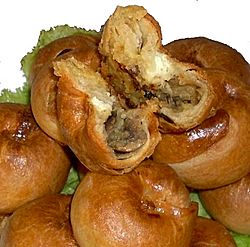Knish facts for kids

Knishes with mashed potato and fried onions
|
|
| Alternative names | Knysh |
|---|---|
| Type | Snack, side dish, finger food |
| Region or state | United States, Israel , other countries with a significant remaining Ashkenazi Jewish population |
| Created by | Jewish communities in Central and Eastern Europe |
| Main ingredients | Mashed potatoes, dough, ground meat, sauerkraut, onions, kasha, cheese |
A knish is a traditional and delicious snack. It comes from Ashkenazi Jewish culture. A knish has a yummy filling wrapped in dough. It is usually baked, but sometimes it is deep fried.
Knishes are often bought from street vendors. You can find them in cities with many Jewish people. Sometimes, you might find them at a hot dog stand or a butcher shop. Knishes are very famous in New York City. They are a big part of New York City food.
This snack became popular in North America. It was brought by Jewish people. These immigrants came from areas like present-day Belarus, Lithuania, Ukraine, and eastern Poland.
What's Inside a Knish?
Most traditional knishes have simple fillings. These include mashed potato, kasha (buckwheat groats), or cheese. But there are many other kinds too! Some knishes have sweet potatoes, black beans, or spinach.
Knishes come in different shapes. They can be round, rectangular, or square. Sometimes, the dough covers the whole filling. Other times, a little bit of the filling peeks out. They also come in different sizes. Some are small, like a single-bite appetizer. Others are big, like a sandwich.
Knishes in the United States
Jewish immigrants brought knishes to the United States. This happened around the year 1900. The word "knish" (קניש) comes from Yiddish. It was taken from the Ukrainian word knysh (книш) and the Polish word knysz.
The first knish bakery in America opened in New York City. This was in 1910. Knishes became very popular in New York City. They were loved by Jewish immigrants in the early 1900s. In the 2000s, knishes became popular again. New knish shops opened in places like Baltimore, Maryland, and Washington, DC.
In the 1900s, politicians in New York City and state would eat knishes. They did this to show they cared about working-class Jewish people. Later, this trend became less common. New rules made it harder to sell knishes from food carts.
See also
 In Spanish: Knish para niños
In Spanish: Knish para niños

